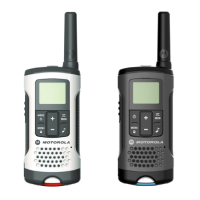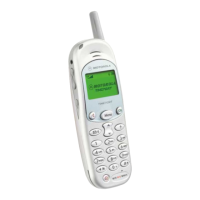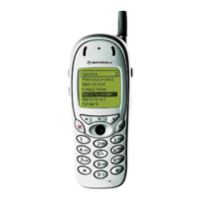Topaz T2688/T200, T2988/T205 L3 Circuit Description
4
Motorola Proprietary Information
9. The balanced signal is then fed into U603 Pins1&2 for GSM and Pins 47 & 48 DCS.
Within the U603 the received signal will now be mixed with the RX VCO to produce
the 1
st
IF Frequency of 225.067Mhz. This signal is out put from U603 as a balanced
1
st
IF output on Pins 42 & 43 (At approximately +25dB from input signal). These are
output on the signal lines MOX and MO.
10. The RX VCO frequency is generated by the RX Dual Band Oscillator U401, which is
controlled by the Frequency Synthesiser IC, IC401 (see page ??), this is fed into U603
on Pin 39 (LO1)
11. Once the 1
st
IF frequency has been fed out, it is fed through Channel select SAW
filter U604 on Pins 1&2, and fed back out on Pins 7&8 the IF then re-enters U603 on
Pin 29(IFINB) and Pin 30 (IFIN). Internal to the U603, the 1
st
will now be down-
converted to a 2
nd
IF.
12. The creation of the 2nd IF is achieved in the following way: A tuning voltage
IF_TUNE, is sent from the Synthesiser IC, IC401 which drives the Varactor D601, at
approximately 1.5V IF_TUNE will drive D601 to produce an output frequency of
540Mhz. This is then fed into U603 Pin 33.
13. Within the U603 the 540Mhz will be go through a ‘Divide by 2’ divider to give
270Mhz, this will be mixed with the incoming 1
st
IF of 225Mhz, to give a resultant
2
nd
IF of 45Mhz, this is then tuned by the 45Mhz tank Circuit consisting of C637 and
L616. The 45Mhz signal carrying the modulation, will then be fed into a phase
comparator, where it will be demodulated by a reference 45 MHz signal created form
the 540Mhz signal which has passed through the ‘divide by 2’ and then though a
‘divide by 6’ divider.
14. We now have our balanced demodulated RXI and RXQ signals, which are fed out on
Pins 20, 21, 22 and 23 are fed to the VEGA IC on Pins 51, 52, 53 & 54.
15. The VEGA IC is split into 3 sections:
? The Voice Processing portion of the IC includes the microphone and speaker
amplifiers, ADC and DAC, speech digital filtering and a serial port.
? The Base-band processing section includes a 2-channel uplink and Downlink
path, a serial port and a parallel port.
The uplink path performs GMSK modulation, D/A Conversion and smoothing
filters to provide the RF circuit with I & Q signals.
The Downlink path performs anti-aliasing (this is where we filter out signals that
are lower than our expected frequency, which are created through under
sampling.) A/D Conversion and channel separation filtering of the I and Q
signals. The serial port allows base-band data exchange with the DSP, with the
Parallel port controlling timing signals.
? The VEGA also performs auxiliary RF functions such as AFC (Automatic
Frequency Control) and AGC (Automatic Gain Control)

